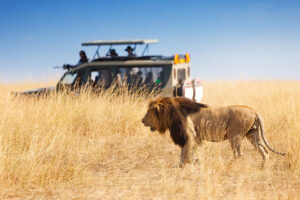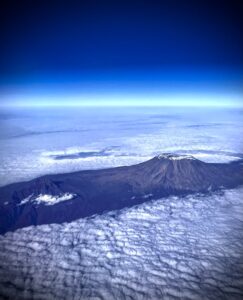Nestled at the foot of Mount Kilimanjaro, Africa’s highest peak, Amboseli National Park is a jewel of Kenya‘s wildlife conservation efforts. Spanning over 392 square kilometers of diverse terrain, Amboseli offers visitors a remarkable safari experience, renowned for its iconic views of vast savannahs, acacia woodlands, marshes, and of course, the awe-inspiring backdrop of Kilimanjaro’s snow-capped peaks. In this comprehensive guide, we’ll delve into the location, activities, attractions, best time to visit, transportation options, and accommodation choices in Amboseli National Park.
Location:
Amboseli National Park is situated in the Kajiado County of Kenya, approximately 240 kilometers southeast of Nairobi, the capital city. It lies close to the Tanzanian border, making it easily accessible from both countries. The park’s coordinates are 2.65° S latitude and 37.25° E longitude.
Activities done in the National Park
Game Drives:
Embark on exhilarating game drives across the park’s vast expanses to witness the diverse wildlife in their natural habitat. Amboseli is famed for its large herds of elephants, which can often be spotted against the backdrop of Kilimanjaro.
Bird Watching at Amboseli National Park:
With over 400 bird species recorded, including migratory birds such as flamingos and pelicans, Amboseli is a haven for bird enthusiasts. Keep an eye out for the lilac-breasted roller, secretary bird, and the iconic African fish eagle.
Cultural Visits:
Experience the rich Masai culture by visiting a local Masai village situated on the park’s outskirts. Learn about their traditional way of life, dance performances, and craftsmanship.
Nature Walks at Amboseli National Park:
Explore the park on foot accompanied by experienced guides to delve deeper into its ecosystems. Discover hidden gems such as smaller wildlife, diverse flora, and breathtaking vistas.
Photography Safaris:
Capture stunning images of Africa’s majestic wildlife against the backdrop of Kilimanjaro’s snow-capped peaks. The park’s unique landscape offers endless opportunities for photographers to immortalize memorable moments.
Attractions in the Amboseli National Park
Mount Kilimanjaro:
The towering presence of Africa’s highest peak provides a dramatic backdrop to the park’s landscape, especially during sunrise and sunset, offering breathtaking photo opportunities.
Elephants at Amboseli National Park:
Amboseli is renowned for its large elephant herds, with some of the largest tuskers in Africa roaming its plains. Witness these magnificent creatures as they traverse the savannah, often dusting themselves with the park’s fine volcanic soil.
Observation Hill at Amboseli National Park:
Climb to the summit of Observation Hill for panoramic views of the park’s vast plains, marshes, and swamps. It’s an ideal spot for sunrise or sunset photography and offers a unique perspective of the surrounding landscape.
Swamps and Marshes at Amboseli National Park:
Amboseli’s marshy areas, fed by underground springs from Kilimanjaro’s melting snow, are home to a variety of wildlife, including hippos, buffaloes, and numerous bird species such as herons and egrets.
Maasai Culture:
Immerse yourself in the vibrant Maasai culture by visiting a local village and interacting with the Maasai people. Learn about their traditional lifestyle, customs, and rituals, including traditional dances and ceremonies.
Best Time to Visit
The dry season, from June to October, is considered the best time to visit Amboseli National Park. During this period, vegetation is sparse, making it easier to spot wildlife congregating around water sources. Additionally, the skies are clear, providing excellent visibility of Mount Kilimanjaro. However, the park can get crowded during this time, so booking accommodations and safaris in advance is recommended.
How to Reach the Park
By Air:
The nearest airstrip to Amboseli National Park is Amboseli Airstrip, which serves domestic flights from Nairobi and other major cities in Kenya. From the airstrip, visitors can arrange for transfers to their accommodations within the park.
By Road:
Amboseli is accessible by road from Nairobi via the Nairobi-Namanga Highway. The journey takes approximately four to five hours, depending on road conditions and traffic. Many tour operators offer guided safari packages with transportation included.
Accommodation at Amboseli National Park
Amboseli Serena Safari Lodge:
Nestled in the heart of the park, Amboseli Serena Safari Lodge offers luxurious accommodation with stunning views of Mount Kilimanjaro. The lodge features spacious rooms, a swimming pool, and guided safari excursions.
Ol Tukai Lodge:
Situated adjacent to the park’s eastern boundary, Ol Tukai Lodge offers comfortable accommodation in traditional African-style cottages. Guests can enjoy panoramic views of Mount Kilimanjaro and daily wildlife sightings from the lodge’s observation deck.
Tortilis Camp at Amboseli National Park:
Set against the backdrop of Mount Kilimanjaro, Tortilis Camp offers a unique safari experience in spacious tents with en-suite bathrooms. The camp also features a swimming pool, sundowner deck, and guided nature walks.
Satao Elerai Camp at Amboseli National Park:
Located on a private conservancy bordering Amboseli National Park, Satao Elerai Camp offers luxury tented accommodation with breathtaking views of Kilimanjaro. Guests can enjoy game drives, bush walks, and cultural visits to Maasai villages.
In conclusion:
Amboseli National Park offers a captivating blend of wildlife, natural beauty, and cultural experiences against the backdrop of Africa’s highest peak. Whether you’re embarking on game drives, bird watching, or cultural visits, Amboseli promises an unforgettable safari adventure for nature enthusiasts and wildlife lovers alike. Plan your visit during the dry season for optimal wildlife viewing opportunities and consider staying at one of the park’s luxurious lodges or camps for a truly immersive experience in the heart of the African wilderness.




